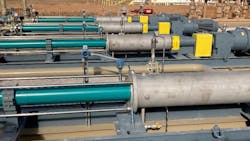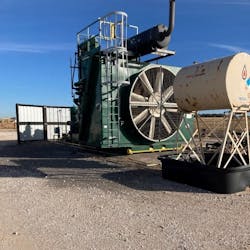How Progressing Cavity Pumps Transformed Oil and Water Transfer at a Midwest Site
Key Highlights
- Conventional centrifugal pumps struggle with pressure variability, viscosity changes, and solids, leading to reduced efficiency and increased maintenance costs.
- Netzsch's NEMO progressing cavity pumps effectively manage pressure fluctuations, viscosity variations, and solids, ensuring consistent flow and high operational reliability.
- The Z-type joint with pressure equalizer allows the pump to handle suction pressures up to 1,000 psi, making it suitable for demanding oilfield applications.
- Partnerships between NETZSCH and DXP provide comprehensive solutions, including heavy-duty skids and expert start-up support, enhancing overall system performance.
Overview of Artificial Lift Methods in Oil Production
When a well in an oilfield is first opened, generally, there is plenty of existing pressure and volume for oil, gas, and water to reach the surface. Over time, however, that initial boost reduces, and artificial lift methods must be applied to literally push those resources to the surface.
The most often used artificial lift methods include progressing cavity pumps (PCP), rod lifts, plunger lifts, gas lifts, hydraulic lifts, and electric submersible pumps (ESP). Each has particular strengths for specific applications.
Why Conventional Artificial Lift Systems Fall Short
Netzsch, in partnership with DXP, began a discussion with a Midwest Oil Producer that (removed the word typically) used the gas lift method. The producer had just constructed a multipad (3) well site, having designed in the gas lift artificial lift method. In this system, high-pressure gas is injected into the wellbore, which forces the fluids to the surface. Each well then feeds the gas and fluids to a dedicated two-phase, horizontal separator, which divides a major portion of the gas from the well fluids.
The gas is then directed back into the compressor for reinjection into the wellbore. The liquids and residual gas (not separated in the initial phase) are then sent to a vertical two-phase separator for additional processing. The residual gas rises to the top of the separator and is fed back to the compressor. The fluids are then forced into the pumping system to be transported through pipelines to a central processing facility (CPF), where the oil is now separated from the water.
The CPF is approximately 15 miles from the well site.
To date, the most common method for moving fluids to the CPF has been the use of centrifugal pumps. However, several issues are encountered when using centrifugal technology.
In this case, the issues are:
- Inability to handle the varying suction and discharge pressures and maintain consistent flow rates.
- Inability to handle the viscosity fluctuations and maintain consistent flow rates.
- Inability to handle solids that may be present in the fluids without extreme wear.
Centrifugal pumps are unable to maintain constant flows when the suction pressures vary. This is also the case when discharge pressures fluctuate. In order to provide consistent flow rates, control valves and other instrumentation must be used to ensure the centrifugal pump is operating at its best efficiency point (BEP). If not, the flows drop off, substantially reducing production.
Viscosity fluctuations are challenging for Centrifugal pumps because flow output is affected. For instance, as viscosity increases, the flow rate of a centrifugal pump will begin to rapidly decrease, and production rates are reduced.
The high-speed impeller rotation of centrifugal pumps cannot handle solids or abrasives without accelerated wear. Because of the high speeds (3,600 rpm), solids and abrasives can cause rapid wear of the impellers, resulting in reduced production and high maintenance costs.
How NETZSCH and DXP Solved Flow and Pressure Challenges
To resolve these issues that this oil producer experienced, NETZSCH partnered with DXP to address each issue. Netzsch NEMO Progressing Cavity (PC) Pumps actually address each issue.
NEMO PC pumps can handle fluctuations in suction and discharge pressures while maintaining a consistent flow rate. In addition, changes in the viscosities of the pumped fluid do not affect the flow rates, allowing production to continue at the highest levels required. Furthermore, the pump speeds are controlled by VFDs to meet production flow rates, and the pumps can meet the pressure demands over a wide speed range.
Last, Netzsch NEMO PC pumps can handle the solids and abrasives that could be present in the fluid with very little wear. This is because of the low internal leakage (slip) inside the pumping elements. which is the result of the tight compression fit between the rotor and stator.
To meet the application conditions provided by the producer (7,500 BPD per pump, up to 250 psi suction pressures, differential pressure of 500 psi), Netzsch engineers selected the NEMO pump model NM076SY06S36Z. Since the producer required a total capacity of up to 30,000 BPD from the three wells, Netzsch recommended the use of four pumps.
The Netzsch NEMO pump was supplied with SAE 316SS materials and a NEMOLAST S459/S91 stator.


